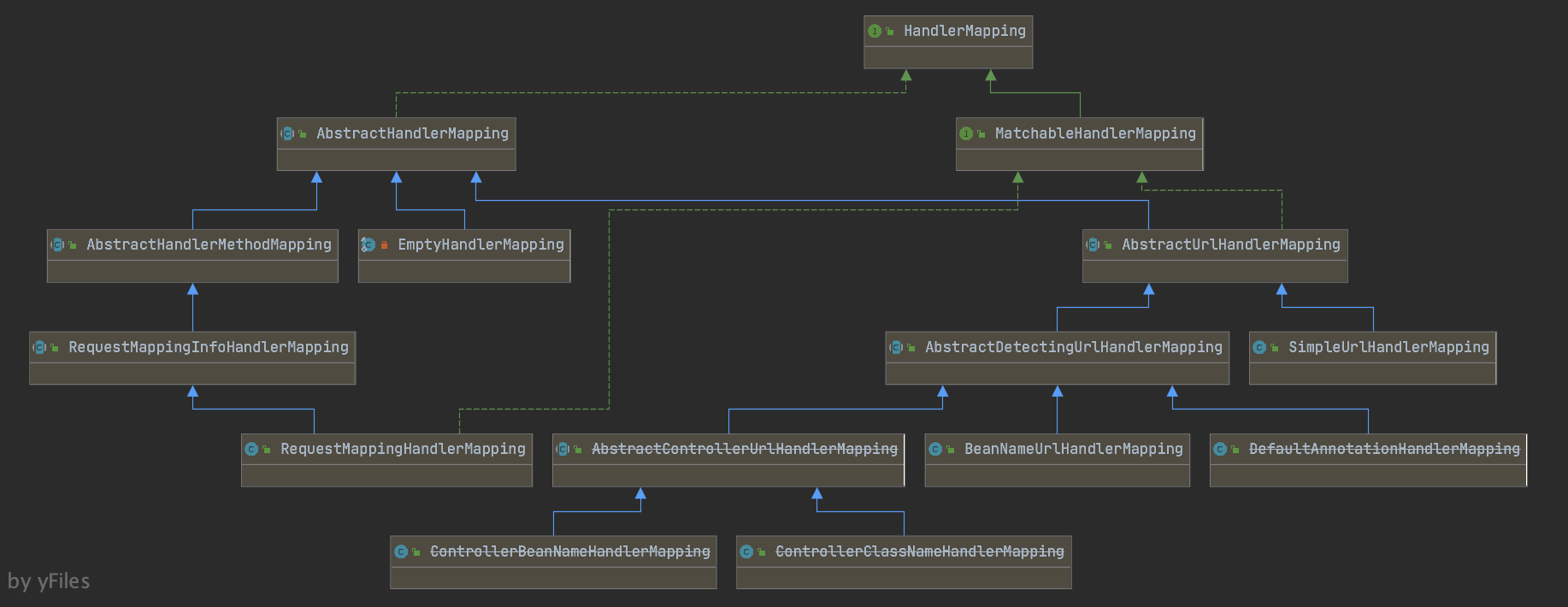HandlerMapping处理器映射器
作用是根据request找到相应的处理器Handler和Interceptors,然后封装成HandlerExecutionChain对象返回
1 | HandlerExecutionChain getHandler(HttpServletRequest request) throws Exception; |
实现类
HandlerMapping帮助DispatcherServlet进行web请求的url到具体处理类的匹配,用来根据请求的url查找Handler,内部维护的Map<String, Object>映射,springmvc提供了不同的映射器实现不同的映射方式,例如:配置文件方式,实现接口方式,注解方式等
1 | private final Map<String, Object> handlerMap = new LinkedHashMap<String, Object>(); |

spring自带了多个处理器映射实现
- BeanNameUrlHandlerMapping 根据控制器Bean的名字将控制器映射到URL
- ControllerBeanNameHandlerMapping 与BeanNameUrlHandlerMapping类似
- ControllerClassNameHandlerMapping 通过使用控制器的类名作为URL基础将控制器映射到URL
- DefaultAnnotationHandlerMapping 将请求映射给使用@RequestMapping注解的控制器和控制器方法
- SimplerUrlHandlerMapping 使用定义在Spring应用上下文的集合将控制器映射到URL
- RequestMappingHandlerMapping SpringMVC3.1新增的,在springMVC3.1之前,DefaultAnnotationHandlerMapping会在类级别上选中一个控制器,然后通过AnnotationMethodHandlerAdapter定位到具体要调用的方法;而在SpringMVC3.1之后,这些操作全都放生在RequestMappingHandlerMapping中,从类级别和方法级别的@RequestMapping注解中获取到路径映射信息,使得在HandlerInterceptor中获取到的处理器肯定是一个HandlerMethod类型
配置
1 | <!-- 开启注解 --> |
mvc:annotation-driven配置的作用
- <mvc:annotation-driven/>会自动注册RequestMappingHandlerMapping、RequestMappingHandlerAdater、ExceptionHandlerExceptionResolver三个bean
- 支持使用ConversionService实例对表单参数进行类型转换
- 支持使用@NumberFormatannotation、@DataTimeFormat注解完成数据类型的格式化
- 支持使用@Vaild注解对JavaBean实例进行JSR 303验证
- 支持使用@RequestBody和@ResponseBody注解
RequestMappingHandlerMapping源码
由于一般都使用<mvc:annotation-driven/>进行配置,所以就以RequestMappingHandlerMapping为例进行讲解
创建
RequestMappingHandlerMapping实现了ApplicationContextAware接口,会执行setApplicationContext
1 | // 调用链路 org.springframework.context.support.ApplicationObjectSupport#setApplicationContext ——>org.springframework.context.support.ApplicationObjectSupport#initApplicationContext(org.springframework.context.ApplicationContext) -->org.springframework.web.servlet.handler.AbstractHandlerMapping#initApplicationContext |
RequestMappingHandlerMapping实现了InitializingBean接口,会执行afterPropertiesSet
1 | // org.springframework.web.servlet.handler.AbstractHandlerMethodMapping#afterPropertiesSet |
访问
在进行访问的时候会通过org.springframework.web.servlet.DispatcherServlet#getHandler方法来遍历handlerMappings
1 | HandlerExecutionChain handler = hm.getHandler(request); |
来调用HandlerMapping的getHandler方法
1 | // org.springframework.web.servlet.handler.AbstractHandlerMapping#getHandler |
getHandlerInternal
1 | // org.springframework.web.servlet.handler.AbstractHandlerMethodMapping#getHandlerInternal |
getHandlerExecutionChain
1 | protected HandlerExecutionChain getHandlerExecutionChain(Object handler, HttpServletRequest request) { |